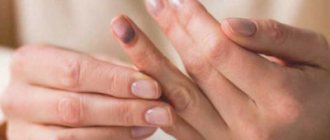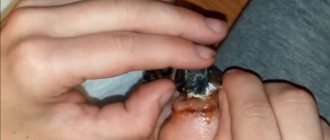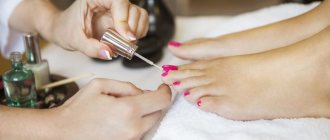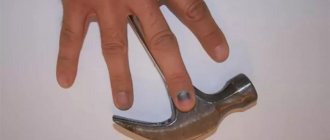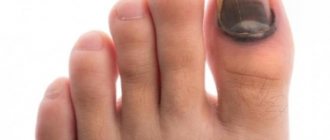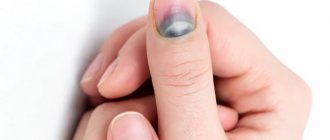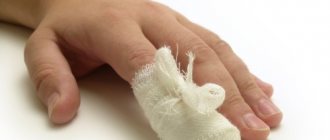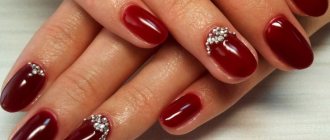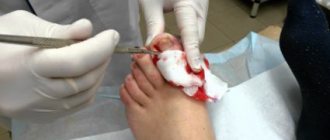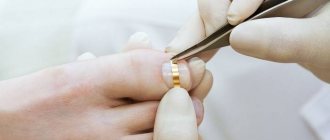Recently, people whose fingernails are coming away from the skin often turn to doctors. Such damage to the nails can be caused by diseases, and in addition, such changes in the condition of the nail plates and the skin around them can be the result of environmental exposure, a lack of nutrients and vitamins. Violation of the nail structure is accompanied by a number of negative emotions and discomfort, and in order to bring your nails back to normal, you need to identify the cause of the altered state.
What kind of disease is this?
The condition when the nail lags behind the finger in medicine is called onycholysis, which includes three types of problem conditions, each of which has a number of characteristic signs:
- Kaylonhinia - in which the middle part of the nail begins to peel off. In this case, an air or blood bubble appears between the skin and the nail.
- Onycholysis is a condition similar to the previous case, but the detachment occurs perpendicular to the nail bed.
- Onychomadesis - in which the nail plate begins to peel off at its base. It is this form that is often accompanied by severe pain and inflammation.
Such types of nail dystrophy are not so rare, which is caused by a disruption in the connections between the nail and the tissues of the bed. Onycholysis is more common on the fingernails, most often on the third and fourth fingers. Toenails are extremely rarely affected by this disease, and only on the big toes.
Detachment of the nail occurs from the edge of the nail in the direction of the nail hole, while its smooth surface, as well as consistency and density remain unchanged, and the color changes to yellowish, gray or brown. As a rule, the peeling affects no more than half of the nail, and it may appear in the form of stripes, a trapezoid, or a crescent. A process affecting the entire nail plate in the form of total onycholysis or onychomadesis is less common and occurs due to significant damage caused by trauma, after taking tetracycline drugs, in the case of paronychia of candidal or strepto-staphylococcal nature in the acute period, alopecia areata or erythroderma .
Causes of nail separation from skin
Common and fairly common reasons for which the nail moves away from the skin on the hand are:
Non-infectious
- injuries received;
- treatment with fluoroquinolone antibiotics;
- poor circulation in the arms or legs;
- contact with chemicals.
Infectious
- fungal infection of the nail and skin around it.
Detachment resulting from various diseases
- psoriasis, dermatitis, eczema;
- functional disorders of the cardiovascular, nervous or endocrine systems.
At the first signs, the symptoms of which are similar to the symptoms of nail detachment, it is necessary to take appropriate measures. For treatment to be effective, it is necessary to find out the causes of this condition, since often they weaken the body’s defenses and provoke various diseases of the skin and nails.
Causes
The reasons for the violation of the nail structure are as follows:
- finger injuries;
- fungal infection;
- circulatory dysfunction;
- exposure to chemicals in gel polish;
- negative impact of taking fluoroquinolone antibiotics;
- ingrown nail;
- poor-quality processing of tools during manicure;
- disorders of the cardiovascular system.
Structural changes in the nail bed after shellac indicate poor quality of the product. Sometimes unpleasant symptoms are caused by an allergic reaction. In this case, after gel polish, not only the nails, but also other organs are affected.
Respiratory allergy symptoms and skin rashes appear. An allergist will tell you what to do. He will prescribe suitable drugs that suppress the release of histamine.
If an allergic reaction develops from gel polish, contact with the irritating substance is first avoided.
Who to contact
A dermatologist determines why fingernails move away from the skin. Before visiting, you should make sure there are no mechanical damages.
Before making a diagnosis, a fungal test is performed. As part of this, scraping is done. The resulting material is analyzed in a special laboratory.
Diagnostics
In case of changes in the condition of the nails, when the nail plates begin to peel off from the skin, an analysis is carried out for the presence of a fungal infection. If the results of the study are negative, the patient is subject to additional examination until the existing reasons that caused changes in the appearance of the nails are identified.
It will help to make a correct diagnosis by visiting a skin and venereal disease clinic or private medical offices, where, using an examination and laboratory tests of the material obtained, results will be obtained, on the basis of which appropriate treatment will be prescribed.
How to treat
The treatment and technique that will be used depend on the cause of the development of nail detachment. The easiest way to treat such an altered condition of the nail plate, which occurs due to injury. It is often enough to carefully care for the damaged area, carefully trim off the growing nail and wait for the peeled nail to be replaced by a healthy one. All this time, it is important to prevent the penetration of foreign microorganisms into the site of damage, for which the cavity in the nail must be treated with agents with antibacterial properties, and then sealed with a band-aid.
The important point is that if the cause of nail detachment is a systemic disease, then local treatment will not have the expected result. In this case, it is necessary to eliminate the underlying disease that caused the damage to the nail.
If the cause of the pathological change in the nail is due to exposure to potent chemicals, it is necessary to exclude any contact with the irritant. Over time, the condition of the nail will become normal.
Detachment of nails caused by taking antibiotics is eliminated over time, and according to experts, although it lasts for quite a long period, it goes away on its own.
The longest time to be treated is a nail whose peeling is caused by a fungal infection. Fungi can spread through the bloodstream throughout the body and completely getting rid of them can take several years. The duration of the treatment course in this case will depend on the stage of the disease and on how far the fungal infection has spread in the body. For treatment, drugs of different types are used in the form of antifungal agents and antifungal drugs. It is important during the treatment period to use auxiliary methods of combating the fungus in the form of baths with soda, salt, potassium permanganate, as well as carry out prescribed physiotherapeutic procedures and follow the recommended diet.
An important point in the treatment of a receding fingernail is compliance with hygiene requirements. It is necessary to immediately treat the gloves and repeat it periodically if the time of year does not allow you to do without them. It is necessary to eliminate allergens from everyday life, no matter what it is - food or household chemicals. To care for the skin of your hands, it is better to use a pharmaceutical cream, which is recommended for people with eczema or dermatitis.
How to treat a peeling nail
Changing the color of the nail plate during onycholysis
What to do if the nail on the finger has moved away from the skin? First, consult a doctor who will conduct a diagnosis and draw up a treatment plan. Therapy directly depends on the cause that caused onycholysis. If it is an injury, then the problem can be easily dealt with: just trim your nails and watch until a completely healthy plate grows back. If this is the result of a disease, then in this case it is impossible to do without medications and traditional medicine. In advanced cases, surgical intervention will be required.
Onycholysis is a persistent disease that cannot be cured quickly. The symptoms will go away only after the nail has grown completely. The goal of treatment is to stop nail peeling and eliminate its symptoms. To get rid of the problem, complex therapy will be required.
Drug treatment
Let us immediately note that all medications should be prescribed only by a doctor. Otherwise, you can only worsen the course of the disease. The following medications may be prescribed:
- If eczema, psoriasis, dermatitis is detected - corticosteroids (Radevit, Heliomycin ointment).
- For bacterial infection - antibiotics (Bifonazole, Ciclopirox, Amorolfine).
- For fungal infections - local medications containing allylamine and imidazole, as well as medications for oral use (Ketoconazole, Fluconazole, Terbinafine, Intraconazole).
In addition, vitamins A and B can be prescribed, since they are considered strengthening agents, as well as preparations containing iron and calcium. It is the lack of these elements that destroys the nail plate.
Do not interrupt the course of treatment without consulting your doctor. This can lead to various complications.
Traditional medicine recipes
When a fingernail comes off, you need to make various lotions and baths based on folk recipes. Traditional recommendations should be used as a complement to drug treatment.
Let's list the most effective means:
- Tea tree oil . Has powerful bactericidal properties. Take a pipette, fill it with oil and carefully place one drop under each affected nail. Do this procedure 2-3 times a day. Course of treatment: month.
- Tea mushroom . Take a small piece that needs to be thoroughly ground, turning it into a homogeneous mushy mass. Gently rub the resulting mixture onto the affected areas. Do this procedure 4 times a day. Course of treatment: 2-3 weeks.
- Sea salt baths . Dissolve 1 tbsp. l. salt in two liters of warm water and place the fingers on which the nails have come off there for 10 minutes. Do this procedure in the evening, before going to bed. Course of treatment: month.
- Orange baths . Mix 1 liter of warm water with freshly squeezed juice of 1 orange, add 5 drops of iodine and 1 tsp. sea salt. Place your hands in the resulting solution for 10 minutes. The procedure must be done every evening for a month.
- Soda lotions . Dissolve 1 tsp in a glass of warm water. baking soda and stir. Soak cotton pads in the prepared solution and apply to the affected nails for 10-15 minutes. The procedure must be done daily for a month.
After baths and lotions, you must use a bactericidal patch.
Surgical intervention
In case of severe pain and severe deformation of the nail (detachment has occurred by more than 1/3), when neither medications nor folk remedies help, it is better to resort to surgical help. The nail plate, being in such a pathological condition, can be susceptible to severe infectious processes. In this case, treatment of the skin comes to the fore, rather than preserving the nail plate.
The operation itself goes quickly. Modern clinics remove nails with laser. In medical institutions where there is no appropriate equipment, removal occurs surgically. It is more traumatic: the nail is separated from the bed in the place where it is attached to the skin. After this, the nail bed must be carefully looked after, as the wound may become infected. Care includes the following:
- do not put pressure on the injured finger;
- constantly make new dressings;
- disinfect damaged tissues.
A new nail does not always grow back. Some time after removal, a hard layer of skin forms on the nail bed. At this point the treatment is considered complete.
Traditional methods
Drug treatment will be more effective if it is supplemented with traditional methods of treating nails. You should not use any prescriptions on your own for this pathology, as complications may arise that will be quite difficult to eliminate. Experts usually recommend taking baths with sea salt, potassium permanganate or decoctions of medicinal herbs when the nail comes off. Affected nails can be wiped with sea buckthorn oil, this will speed up the regeneration process of damaged tissue. There are many folk ways to maintain healthy nails or speed up their recovery in case of illness, for example:
- baths with olive oil, which is preheated until warm and the nails are dipped into it;
- make masks from black currants, lingonberries or cranberries, pre-chopped and applied to the nail;
- one of the effective folk methods of treatment is Dead Sea salt, which is diluted in warm water and the affected nail is kept there;
- Compresses with alum, which are dissolved in water, add glycerin, moisten a napkin in this composition and apply to the nail;
- Baths with a decoction of chamomile and green tea effectively treat the affected nail;
- a mixture of gelatin, which is placed in water and heated in a water bath in which the nails are kept;
- treatment of the affected nail plate with iodine, which is applied before bedtime.
Prevention
To avoid a problem such as nail detachment, it is better to try to take the necessary preventive measures. To do this, you need to follow some recommendations, namely:
- increase the body's immune defense;
- when treated with antibiotics, take antifungal agents;
- take care of your nails, trim them in a timely manner and clean them from dirt;
- after swimming in ponds or pools, use antibacterial soap to wash your hands and feet;
- Perform a manicure only after disinfecting the instruments;
- When using chemicals for washing and cleaning, protect your hands with gloves;
- improve blood circulation in the fingers by massaging them when applying the cream.
Therapeutic methods
To treat onycholysis, so-called restorative therapy is used. As a rule, this includes a number of vitamins and nutrients: iron, calcium, gelatin, vitamins A and B. After the body is strengthened, it will be possible to move on to treating the nails themselves. Potassium permanganate baths, heliomycin ointment, and syntamycin emulsion are used. To prevent infection by other microbes or fungi, you need to maintain hygiene of your hands and feet, and constantly clean your nails. Also, do not come into contact with chemicals, powders, detergents, and so on. It is enough just to wear rubber gloves, which will prevent the substance from penetrating the skin and nails. If you go to the doctor in a timely manner, the emptiness under the nails of your big toes can be treated quite simply.
What to do if your nail still hurts?
The onset of nail peeling is not accompanied by pain, but over time, an infectious agent can penetrate into the cavity formed under the nail plate, after which the infection spreads to the soft tissues under the nail. As a result, ulcers form under the nail, which become inflamed and accompanied by the release of pus. This condition threatens with more serious consequences when the nail completely falls off the finger. Unfortunately, the development of such a pathological disorder occurs very rapidly, and if the necessary measures are not taken, then after six months you can completely lose your nail, and there is no guarantee that it will grow back. In addition, there is still a threat that the infection will spread to neighboring fingers and affect all the nails on the hand.
The pain that accompanies nails affected by complications is sometimes unbearable, and therefore it is necessary to contact specialists as soon as possible, take the necessary tests and determine what caused the painful changes. Only proper treatment will relieve pain and preserve your nails.
Main causes of the disease
If the void under the nails is noticed only at the initial stage, then the detachment of the plate will be insignificant and barely noticeable to a prying eye. But if you start onycholysis, then things can get to the point where the nail is completely lost. And this is a huge stress for the whole body and person.
The main reason is fungal infections, which can be spread under the nails in a variety of ways. Therefore, the specialist you need to contact is a dermatologist. It is he who will be able to prescribe appropriate treatment, send for tests and give useful advice on prevention. Since the disease develops very quickly and covers the entire space between the fingers, contacting a specialist as soon as possible will help cope with the fungus.
But there are other reasons that are not so common: taking antibiotics, herbs, exposure to drugs, powders, and so on. Because the nature of the formation can be so varied, it is important to contact a specialist as soon as possible. Only he can prescribe the correct treatment so that the emptiness under the nails goes away.
Nail comes off after shellac
Often, those who do not have their own beautiful and strong nails use various methods in the form of false nails or shellac. However, after removing them, your nail becomes even more fragile and often peels off from its bed or suffers from delamination. There are several ways to correct this condition and improve the health of your nails after shellac removal:
- using nourishing oil, which is used to lubricate the nail plates, and since the treatment will take a long time, at least three months, the type of oil can be changed;
- salt baths, the duration of which should not be less than twenty minutes, will help restore a healthy appearance to your nails;
- lubricating thinned and peeling nails with olive oil, as well as lemon juice or iodine;
- special products for nourishing nails and cuticles nourish and restore nails well after removing shellac;
- carry out paraffin masks by dipping your fingers into warm paraffin.
Nail separation when using shellac can be caused by improper removal, individual intolerance to one of the components of the varnish, improper nail care, penetration of water immediately after application, or impaired integrity of the edge of the nail plate. If any deviations in the condition of the nail are noticed after this procedure, it is necessary to urgently begin to eliminate them.
What should I do if I didn’t hit myself and it’s not a fungus?
What should you do if you notice a fingernail coming away from the skin? Since there are many reasons for this and they may not necessarily be a fungus or injury, it is necessary to consult a dermatologist on this issue. Such manifestations may be symptoms of various diseases, and as a result of the examination, it will be possible to determine their presence and begin treatment. Sometimes such changes in the condition of the nails can be a sign of a lack of vitamins, so it will be important to conduct a course of vitamin therapy. If the detachment of the nail from its bed occurred due to diseases, then timely treatment will get rid of them and bring the appearance of the nail back to normal.
How to treat fungus?
If a nail fungus is detected, the nail has moved away from the skin, this indicates an advanced stage of the disease. To treat it, it is important to consult a dermatologist for an adequate diagnosis. It is needed even if you know for sure that it is a fungus. It can be caused by various microorganisms that react differently to medications.
Most likely, systemic medications will be prescribed. Taking tablets can be combined with the use of local remedies. If the nail is peeling, removal is often recommended. The procedure provides the following benefits:
- Local preparations work better if they are applied not to the plate, but to the nail bed;
- Stops the spread of infection;
- The discomfort stops.
Advances in medicine make it possible to carry out the removal completely painlessly. For this purpose, special preparations are used, for example, Nogtimycin, which soften the plate as much as possible. After a few procedures, it easily disappears on its own. To carry out the procedure, you need to apply the product to the nail, avoiding the skin, and wait, depending on the medication, from 2 to 4 days.

